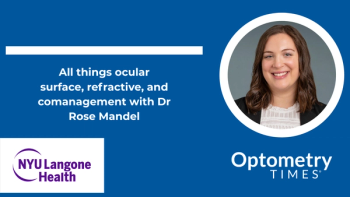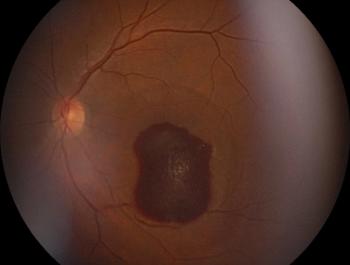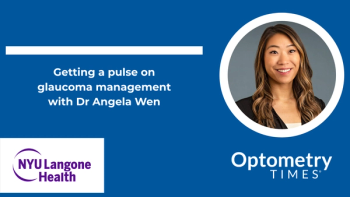
- September digital edition 2023
- Volume 15
- Issue 09
Allergic conjunctivitis is prevalent in youngsters
Set your young patients—and their caregivers—up for success in treatment.
As eye care professionals, we are overly sensitive to anyone we see with red eyes or—heaven forbid—anyone rubbing their eyes with such intensity that we cannot help but try to offer assistance. I have recommended products in the artificial tear aisle to someone just standing there, overwhelmed with questions and options. Imagine if they were trying to choose for a child. They may be thinking, “I can barely handle eye drops,” already doubting their own skill or willingness for their child to accept drops.
We know when something is blooming or when the air quality is poor based on the number of phone calls and urgent add-on appointments for redness, itching, swelling, and irritated eyes we receive in clinic. Yet, we only see about 10% of the 40% of persons having issues.1,2 Not only is the child’s quality of life affected, especially at school, but also their parents’/caretakers’ quality of life by worrying about them and the stress of having a “sick” child. In fact, 29% of respondents report that their child’s daily life was affected “a lot.”3
Those we do see have tried a multitude of OTC options that do not offer enough relief, so that they continue to experience exacerbations. The variability of all aspects of the process is different for every patient, including the tissues most affected: eyes, nose, skin, and throat. We also consider any comorbidities of asthma, eczema, and medication adverse effects such as dry eye. Do not forget about mechanical trauma of contact lenses or little hands rubbing their eyes.
Allergic conjunctivitis (AC) is one of the most prevalent
VKC is a chronic allergic conjunctivitis in children presenting with itching (usually severe), watering, foreign body sensation, papillary reaction, and corneal involvement (sometimes with photophobia). They can present with acute exacerbations in the spring/summer. This is most common in young males. The pathogenesis of this chronic inflammation is Th2-lymphocyte mediated and therefore allergy testing to IgE antibodies can be negative. There are 3 forms: palpebral, limbal, and mixed, usually presenting in all forms with giant papillae.5
AKC involves chronic degranulation of the mast cell by IgE and Th1 and Th2 immune mechanisms along with other inflammatory cells. This is the ocular counterpart of atopic dermatitis or eczema.5
All of these have evidence of mast cell activation and eosinophil attraction and activation.6
Even though
Treatments
First-line management is avoidance. Tell your patients, “Don’t touch your eyes. Wash your hands after you pet that cat or dog.” Tell them to wash their clothes and bedding often and have children bathe before bedtime. Similarly, do not scratch that bug bite. Manually degranulating all those mast cells will make it 100 times worse.
First-line strategies also involve protection of the ocular surface, which can include use of artificial tears (preferably without preservatives, as we do not want them to also be allergic to the preservative). Trigeminal ganglion cold thermoreceptor neurons that express TRPM8 innervate the cornea.9 Artificial tears have been proposed to act as wetness sensors detecting evaporation-evoked corneal temperature changes, which adjust basal tear secretion and blinking rate, thereby preventing desiccation of the ocular surface. I have found that cold, refrigerated drops are very helpful, possibly due to these cold receptors.10 However, Bitton et al found that the temperature of the drop did not affect comfort, although this was in a study of 18 patients without symptoms.11 Again, if the child or parent refuses eye drops, it has been shown that cold compresses for 30 seconds, 3 times daily are as effective as artificial tears 3 times daily.
Second-line treatment consists of eye drops with antihistamine, mast cell stabilizer actions, or dual actions and most of these have gone OTC (Table). I would recommend demonstrating eye drop insertion on the child to help the parent, as I am sure you have great tips. Third-line treatment for more severe reactions is pulse treatments with steroid eye drops to control flare-ups, especially those with keratitis. I normally prescribe the steroid at 4 times daily for 2 weeks and then re-evaluate and taper according to signs and symptoms or switch to a second line treatment for long term therapy.
Cyclosporine has also been shown to significantly inhibit the increase in vascular permeability and histological evaluations showed suppressed degranulation of mast cells in PAC and VKC.
Oral antihistamines can be used if the patient is experiencing other systemic allergic signs including eyelid edema. Cetirizine (Zyrtec) and levocetirizine (Xyzal) liquid can be used in children older than 6 months as directed. Other OTC liquid options such as diphenhydramine (Benadryl), loratadine (Claritin), or fexofenadine (Allegra) require the child to be 2 years or older. All require the child to be 6 years and older for the chewable tablets.
Adjunctive treatments such as nonsteroidal anti-inflammatory drugs have been approved by the FDA for seasonal allergic conjunctivitis. Other measures include lid hygiene with tea tree oil (TTO), also known by its Latin botanical name of Melaleuca alternifolia, or hypochlorous acid (HOCl). TTO has been shown to reduce histamine-induced skin inflammation, including contact hypersensitivity response.
HOCl is created by our white blood cells to fight pathogens and is termed nature’s disinfectant. The application of HOCl reduced the bacterial load significantly without altering the diversity of bacterial species remaining on the skin under the lower eyelid. How is this important in allergic conjunctivitis? HOCl ophthalmic spray can counteract harmful inflammatory responses and show an improvement in itching, pain, and scarring and can reduce steroid treatment times.
TTO and HOCI come in a variety of formulations, and it is important to ensure patients are not using full-strength TTO essential oil but a formulation for the ocular surface. For example, Optase has a lid wipe version or a cleaning gel. HOCl also has a variety of formulations such as SteriLid, Avenova, Bruder Hygienic Eyelid Solution, and the We Love Eyes mist hypochlorous spray, to name a few. I also love the eyelid margin cleansing brush from We Love Eyes. You can spray the solution directly on the skin or onto the brush and clean the lid margins. This is very easy for children to do.
New treatment options will try to target cytokine levels (markers of disease) found in tears and conjunctiva as targets of therapeutic intervention.6 A new combination topical solution with hyaluronic acid 0.2% and arnica extract 0.1% was found to be helpful in reducing dry eye symptoms in a population of pediatric patients. This will prove to also be helpful in PAC and VKC.
Out west we have a fire season that will be here in late summer, bringing on allergy symptoms. Poor air quality causes inflammation from respiratory and ocular irritants that give you those nose and throat problems with burning and watery eyes. Overall, there has been a rapid increase in the prevalence of allergies and different environment exposures are likely the culprit.12 For instance, exposure to indoor microbial factors may be either protective or create risk of developing atopic disease or food allergies.13 This is an important area of research moving forward and we will continue to be there to manage these patients’ symptoms. So next time you find yourself in the eye care aisle, bring your business cards.
References
1. Singh K. Axelrod S. Bielory L. The epidemiology of ocular and nasal allergy in the United States, 1988-1994. J Allergy Clin Immunol. 2010; 126: 778-783
2. Bielory BP, O’Brien TP, Bielory L. Management of seasonal allergic conjunctivitis: guide to therapy. Acta Ophthalmol. 2012 Aug;90(5):399-407. doi: 10.1111/j.1755-3768.2011.02272.x. Epub 2011 Nov 8. PMID: 22067457.
3. Bielory L. Skoner D.P. Blaiss M.S. et al. Ocular and nasal allergy symptom burden in America: the Allergies, Immunotherapy, and Rhinoconjunctivitis (AIRS) surveys. Allergy Asthma Proc. 2014; 35: 211-218
4. Fan Z, Yang B, Sun L, Zhang T, Zhang SY, Jin L, Liu Y, Liang L. Effect of Anti-allergic Therapy on Quality of Life in Children with Allergic Conjunctivitis and Their Parents. Ocul Immunol Inflamm. 2022 Aug 1:1-7. doi: 10.1080/09273948.2022.2103830. Epub ahead of print. PMID: 35914318.
5. La Rosa M, Lionetti E, Reibaldi M, Russo A, Longo A, Leonardi S, Tomarchio S, Avitabile T, Reibaldi A. Allergic conjunctivitis: a comprehensive review of the literature. Ital J Pediatr. 2013 Mar 14;39:18. doi: 10.1186/1824-7288-39-18. PMID: 23497516; PMCID: PMC3640929
6. Stahl JL, Barney NP. Ocular allergic disease. Curr Opin Allergy Clin Immunol. 2004 Oct;4(5):455-9. doi: 10.1097/00130832-200410000-00020. PMID: 15349048.
7. Buzzonetti L, Petroni S, Federici M. Effectiveness of hyaluronic acid and arnica extract ophthalmic solution in reducing dry eye symptoms in pediatric population. Eur J Ophthalmol. 2022 Oct 2;33(2):11206721221128670. doi: 10.1177/11206721221128670. Epub ahead of print. PMID: 36189925; PMCID: PMC9999266.
8. Craig JP, Nichols KK, Akpek EK, Caffery B, Dua HS, Joo CK, et al. TFOSDEWS II definition and classification report. Ocul Surf 2017;15:27683.
9. Piña R, Ugarte G, Campos M, Íñigo-Portugués A, Olivares E, Orio P, Belmonte C, Bacigalupo J, Madrid R. Role of TRPM8 Channels in Altered Cold Sensitivity of Corneal Primary Sensory Neurons Induced by Axonal Damage. J Neurosci. 2019 Oct 9;39(41):8177-8192. doi: 10.1523/JNEUROSCI.0654-19.2019. Epub 2019 Aug 30. PMID: 31471469; PMCID: PMC6786815
10. Andrew Kao, Robert Latkany; Use of Artificial Tears vs Cold Compresses for the Treatment of Dry Eye. Invest. Ophthalmol. Vis. Sci. 2013;54(15):6052.
11. Bitton, E., Crncich, V. and Brunet, N. (2018), Does the temperature of an artificial tear affect its comfort?. Clin Exp Optom, 101: 641-647. https://doi.org/10.1111/cxo.12664
12. Jackson, C.M., Kaplan, A.N. & Järvinen, K.M. Environmental Exposures may Hold the Key; Impact of Air Pollution, Greenness, and Rural/Farm Lifestyle on Allergic Outcomes. Curr Allergy Asthma Rep 23, 77–91 (2023).
13. Mahdavinia, M, Greenfield, LR, Moore, D, et al. House dust microbiota and atopic dermatitis; effect of urbanization. Pediatr Allergy Immunol. 2021; 32: 1006– 1012. https://doi.org/10.1111/pai.13471
Articles in this issue
about 2 years ago
More optometrists are using amniotic membraneabout 2 years ago
Handling comorbidities prior to surgeryabout 2 years ago
Early CAM therapy kick-starts healingabout 2 years ago
EyeCon 2023 empowers clinical engagement in a relaxed settingabout 2 years ago
Cerebral visual impairmentabout 2 years ago
Taking your practice revenue to the next levelabout 2 years ago
Ocular allergies and dry eye disease: Overlapping treatment optionsabout 2 years ago
Multifocals for all agesNewsletter
Want more insights like this? Subscribe to Optometry Times and get clinical pearls and practice tips delivered straight to your inbox.




















































.png)


